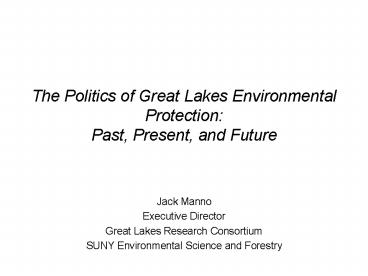The Politics of Great Lakes Environmental Protection: Past, Present, and Future - PowerPoint PPT Presentation
1 / 30
Title:
The Politics of Great Lakes Environmental Protection: Past, Present, and Future
Description:
Chronological List of Great Lakes Political Themes. 1) Access. 2) Resource Extraction ... of freshwater, splendid forests, plentiful animals, rich soil, ... – PowerPoint PPT presentation
Number of Views:48
Avg rating:3.0/5.0
Title: The Politics of Great Lakes Environmental Protection: Past, Present, and Future
1
The Politics of Great Lakes Environmental
ProtectionPast, Present, and Future
- Jack Manno
- Executive Director
- Great Lakes Research Consortium
- SUNY Environmental Science and Forestry
2
Goals
- Understand link between biophysical and
political. - Appreciate complex history of Great Lakes
policy. - Discuss implications of current biophysical
changes for GL institutions.
3
- The majority of the Earths surface is covered by
water only 0.003 of that water is fresh, and
much of that is frozen in polar ice.
4
- The Great Lakes contain 90 of the U.S. supply of
fresh water, and fully 20 of the worlds supply.
5
- Range of Limnological Conditions
- Cold deep Lake Superior, warm shallow Lake Erie
One system, many individual systems.
6
- Natural transition zone
- hard, ancient rocks of the Canadian shield in
the north, younger, more fertile layers of
limestone and other sedimentary rocks to the south
7
- Ecological zones
- Jack pines to the north (Superior), hardwoods of
the Carolinian forest (Lake Erie)
8
What Makes Something Political?
- Problem exists or can be anticipated that
transcends individuals/affects the commons - Benefits and costs are inequitably shared across
space, time or class - Problem is amenable to collective responses (or
can be made so) - Some apparent or real conflict exists between
competing interests
9
Chronological List of Great Lakes Political Themes
1) Access 2) Resource Extraction 3) Resource
Management 4) Public Health 5) Pollution Cleanup
6) Persistent Toxics 7) Pollution Prevention 8)
Ecosystem Approach 9) Sustainable Development
10
USEPA REPORT TO CONGRESS ON THE GREAT LAKES
ECOSYSTEM-- February 1994
- Before its development, the Great Lakes region
was endowed with extraordinary natural
abundance--oceans of freshwater, splendid
forests, plentiful animals, rich soil, immense
wetlands, multitudes of waterfowl. Waters teemed
with fish. Sturgeon up to 6 feet long were
common. A fisherman using a dip net could reap
many hundreds of whitefish in a day. - Today, few sturgeon survive. Lake trout
populations are not self-sustaining. Habitat
available to fish and wildlife is greatly
reduced, as are their populations.
11
- Great Lakes Politics at this time involved access
to hunting and fishing grounds frequent warfare
resulted.
To achieve peace among the Six Nations Iroquois
Confederacy, oral history says that the Peace
Maker enacted the Great Law of Peace. This
founding constitution of the Six Nations has been
considered the precursor to the U.S. Constitution.
12
Arrival of Europeans
- At this time, politics dealt with shipping
routes, beaver trade, and portage trails,
especially along the Niagara River. - Resource exploitation began a period of
destruction, as forests were clear-cut,
temperatures in streams increased, and streams
were clogged with the log running of the regional
lumber industries.
13
(No Transcript)
14
Early Public Health Issues in the Great Lakes
- 1854 Chicago experiences cholera epidemic
because of sewage contamination of drinking
water. - 1870s Hamilton, Ontario can no longer draw
drinking water from Hamilton Harbour because of
contamination. - 1891 Sewage contamination of drinking water in
Chicago causes typhoid epidemic.
15
Era of Resource Exploitation/RapidIndustrializati
on (end of the 19th Century)
- Deforestation
- Dam Construction
- Filling of Wetlands
- Dumping of Sewage
- Uncontrolled Commercial Fishing
- Sea Lamprey
16
Boundary Waters Treaty Background
- In the late 19th century, technology made it
possible to alter system significantly - Drinking water pollution a major concern
- Neither party to the Boundary Waters Treaty
shall pollute the boundary waters on either side
to the injury of health or property on the
other. - Proposed dams and diversion on the US side
without consulting Canada - Michigan - Mississippi
- Dam outlet of Erie to drain Niagara
17
Boundary Waters Treaty of 1909
- Treaty Between the United States and Great
Britain Relating to Boundary Waters, And
Questions Arising Between the United States and
Canada. - Formal recognition of shared responsibility
- Created International Joint Commission
- Applications and References
- Most future US-Canadian agreements get their
legal status through the Boundary Waters Treaty
18
Eutrophication
View from above Lake 226 divider curtain in
August 1973. The bright green colour results
from bluegreen algae (Cyanobacteria), which are
growing on phosphorus added to the near side of
the curtain.
19
1960s Large Predator Fish are Depleted
- Ecological Instability
- Huge explosion of Alewives
- Massive algal blooms
20
Answer Twofold Stocking Top Predators
Reducing Nutrient Inputs
21
1969 - Cuyahoga River in Flames
22
Politics of CooperationThe Great Lakes Water
Quality Agreement
April 15, 1972 Prime Minister Pierre Trudeau and
President Richard Nixon sign the Agreement
23
Toxic Chemicals
Birth defects in colonial waterbirds throughout
the Great Lakes
Mouth and skin tumors in brown bullhead
associated with contaminated sediments.
24
Exotic Species
25
(No Transcript)
26
Key Issues in the Great Lakes at Present
- Water Quality
- - nutrients
- - toxic organisms
- - new chemicals
- Water Quantity
- - diversions/export
- - levels
- - consumption
- Management
- - resources
- - ecosystems
- - land use
- - ANS
27
Issues and Agencies
28
GL Policy Periods
29
Future Issues
- Effects of climate change
- Ecological surprises (ANS)/reducing
uncertainty/ecological forecasting. - Water consumption/diversions
- Sustainable development
- Water level management
30
Your thoughts
- As we face changes in the Great Lakes system, how
does the institutional system need to change with
it? - Questions and Comments.






























